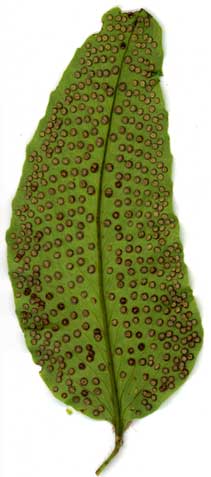|
Hardy Fern Home C. macrophyllum resources
All Ferns � Dryopteridaceae �� Cyrtomium
�Other Genera
|
| Cyrtomium macrophyllum | ||
Big leaf holly fern | ||
|
Etymology
The common name is a perfect translation. Macro means large, and phyllum means leaf, originally from the Greek word, phyllon.
Description
Rhizome: erect, massive, bearing a few fronds, scales lanceolate, rather suddenly narrowing to rhizome apex, larger ones commonly 1 cm long, soft-papery, dark brown, polished.
Frond: 70 cm high by 30 cm wide, evergreen, monomorphic, blade/stipe ratio: 1:1 to 2:1. Stipe: straw-colored, with dark base, scaly but more sparse upwards, scales of upper portion narrower to linear, dark brown, lustrous, vascular bundles: 4 or more, in an arc. Blade: 1-pinnate, oblong-lanceolate, papery, glabrous. Pinnae: 2 to 8 pair, rounded at base, pointed at the tip, the terminal one usually larger; veins netted. Sori: many, round, scattered on lower surface of lateral pinnae, indusium: peltate, green to grayish white or bicolored, falling early, central, sporangia: brown. Culture
Habitat: on humus-rich ground in dense forests.
Distribution: Bhutan, China, India, Japan, Nepal, Pakistan, Taiwan, Tibet.
Hardy to -20�C, USDA Zone 6.
Distinctive Characteristics
a larger plant than C. caryotideum with larger pinnae and fewer pinnae pairs
Synonyms
Aspidium falcatum (L.) Sw. var. macrophyllum Makino Polystichum macrophyllum (Makino) Tagawa |
|
|

Cyrtomium macrophyllum. Pinna from frond above. Click through for enlargement showing sori at center of pinna. �Photo: Tom Stuart |
